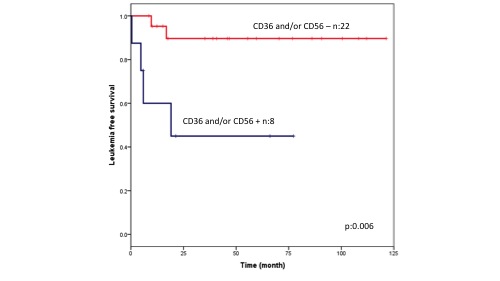Abstract: PB1668
Type: Publication Only
Background
CEBPA is a transcriptional co-factor of RUNX1 which play a major role in the fate decissions associated with physiologic myelopoiesis. Biallelic CEBPA mutations (dm) define an homogenous molecular subgroup which is associated with a favorable outcome. CEBPA mutations may be transmitted in the germ line giving rise to clusters of familial leukemias.
Aims
To analyze the immunophenotypic findings assessed by multiparametric flow cytometry in a consecutive series of de novo CEBPAdm AML.
Methods
Thirty-nine adult patients with de novo AML and CEBPAdm who where enrolled on the AML-03 and AML-12 protocols of the Spanish CETLAM cooperative group were included in this study The immunophenotypic analysis was performed on erythrocyte-lysed bone marrow (BM) samples obtained at diagnosis. Antigenic expression of leukemic cells was systematically analyzed by multiparametric flow cytometry using four-color staining. The antigens studied were: CD45, CD34, HLA-DR, CD10, CD20, CD19, CD2, CD33, CD7, CD117, CD66, CD13, CD64, CD36, CD56, CD14, CD123, CD61, CD42b, glycophorin, CD71, CD11b, myeloperoxidase, CD79a, CD3, TdT, lysozyme and lactoferrin. At least 10.000 events/tube were measured. Analytical gates were established according to CD45 reactivity and to FSC/SSC pattern.Positivity thershold was established at 20%. The FACS-DIVA,Paint-a-Gate and Infinicyt software programs were employed for analysis. Amplification of overlapping PCR products covering the whole CEBPA coding sequence followed by Sanger sequencing were used to investigate CEBPA mutations. FLT3-ITD, NPM1, MLL-PTD, WT1 and GATA2 mutations were also investigated by conventional PCR-based molecular methods.
Results
Antigen reactivity was as follows: CD45 (39/39,100%), CD15 (35/39, 90%), CD34 (36/39,92%), HLA-DR (39/39,100%), CD33(39/39,100%), CD2(2/39,5%), CD7(36/39,92%),CD117(39/39,100%), CD13(37/39,95%), CD56(6/39,15%), CD36 (6/39, 15%), CD123(39/39, 100%), CD14(1/39,0.02%),CD71(38/39,97%),myeloperoxidase (38/39, 97%).In nine cases CD36 and/or CD56 expression on leukemic blasts was greater than 20% Those CD36/CD56+ cases had a shorter overall survival and leukemia free survival (see graph). Four out five tested CD36/CD56+ cases also showed GATA 2 mutations. An additional CD36/CD56+ case had a FLT3-ITD. In three out 39 cases (7%) a population showing cytoplasmic CD79a reactivity was detected (8%, 11%,14% of the neoplastic population, respectively). Two of those cases had also a FLT3-ITD.

Conclusion
CEBPAdm cases showed an homogeneous immunophenotype with positivity for CD45, CD7,CD34,CD123,CD117, HLA-DR, CD71,CD33,CD13 and CD15. CD36 and/or CD56 overexpression was detected in a subgroup of cases (9/39, 23%) with an adverse outcome. The current findings suggest that CD36 and CD56 reactivity should be investigated in larger series of CEBPAdm AML cases. Small leukemic populations with B-cell markers are not uncommon in CEBPAdm AML (3/39, 7%).
Session topic: 3. Acute myeloid leukemia - Biology





